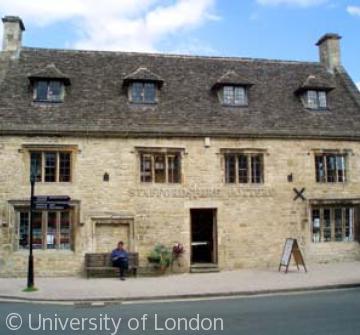High Street (east): No. 33

Built probably around 1500 for an unknown owner, this must have been quite a grand house, its long rubblestone façade straddling two medieval plots. The earliest feature is the damaged Tudor-arched blocked doorway to the left of the present (1980s) front door. The large stone-mullioned windows are 17th-century insertions. By the 1840s it had been subdivided like so many Burford houses, the northern part occupied by the whitesmith, spring-maker and musical-instrument maker Henry Titcomb (1840s–60s), and the other part by a greengrocer. A rear wing was probably added soon after it was reunited c.1880, perhaps for the furniture dealer Bartholomew Fisher (occupant 1890s–1910s).
Around 1920 E.J. Horniman of The Priory acquired the building and heavily restored it, in line with his Arts and Crafts leanings (cf. 99 and 117 High Street). The restored roof with two rows of purlins can be seen inside the current shop. The building was vested in the Horniman Trust, and used first as a gymnasium for Burford Grammar School, and by the 1950s as a metalwork shop. In 2007 it was the Staffordshire Pottery shop.
Content generated during research for the paperback book 'Burford: Buildings and People in a Cotswold Town' (ISBN 13 : 9781860774881) for the England's Past for Everyone series

